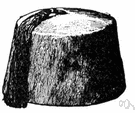tarboosh
(redirected from tarbush)Also found in: Thesaurus.
tar·boosh
also tar·bush (tär-bo͞osh′)n.
See fez.
[Modern colloquial Arabic ṭarbūš, perhaps from Spanish traposo, ragged, or trapucho, old rag, worthless item of clothing (perhaps used as a slang term for the tarboosh, the typical male headwear of the Maghreb, by Moriscos who settled in the Maghreb after their expulsion from Spain in the 1600s) , from trapo, rag, from Late Latin drappus, cloth, perhaps of Gaulish origin.]
American Heritage® Dictionary of the English Language, Fifth Edition. Copyright © 2016 by Houghton Mifflin Harcourt Publishing Company. Published by Houghton Mifflin Harcourt Publishing Company. All rights reserved.
tarboosh
(tɑːˈbuːʃ) ,tarbush
ortarbouche
n
(Clothing & Fashion) a felt or cloth brimless cap resembling the fez, usually red and often with a silk tassel, worn alone or as part of a turban by Muslim men
[C18: from Arabic tarbūsh]
Collins English Dictionary – Complete and Unabridged, 12th Edition 2014 © HarperCollins Publishers 1991, 1994, 1998, 2000, 2003, 2006, 2007, 2009, 2011, 2014
tar•boosh
or tar•bush
(tɑrˈbuʃ)n.
a tasseled felt or cloth hat resembling a fez, worn by Muslim men.
[1695–1705; < Arabic ṭarbūsh < Ottoman Turkish terposh, probably < Persian sarposh headdress (sar head + pūsh covering), by association with Turkish ter sweat]
Random House Kernerman Webster's College Dictionary, © 2010 K Dictionaries Ltd. Copyright 2005, 1997, 1991 by Random House, Inc. All rights reserved.
ThesaurusAntonymsRelated WordsSynonymsLegend:
Switch to new thesaurus
| Noun | 1. |  tarboosh - a felt cap (usually red) for a man; shaped like a flat-topped cone with a tassel that hangs from the crown tarboosh - a felt cap (usually red) for a man; shaped like a flat-topped cone with a tassel that hangs from the crowncap - a tight-fitting headdress |
Based on WordNet 3.0, Farlex clipart collection. © 2003-2012 Princeton University, Farlex Inc.